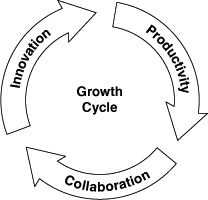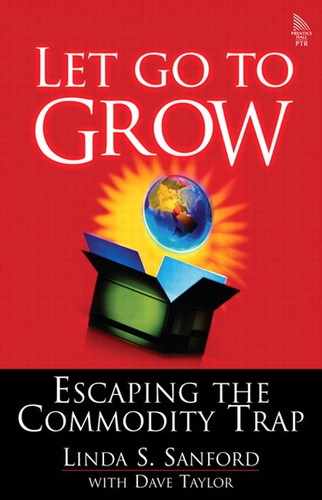Preface—Let Go To Grow
Sustained revenue growth is hard. The odds of a company maintaining a growth rate above the Gross National Product are worse than one in ten. Markets are in such a state of flux that responding to the challenges of the marketplace with traditional business strategies does little more than let a firm survive.
This difficult business environment has been fueled by technological advances that enable suppliers and customers to work hand-in-hand, globally and in real time, remaking the way companies need to operate.
There are big winners in this economy, though. These winners are creating new opportunities by driving productivity, collaboration, and innovation in concert—through their businesses and relationships—to create a cycle of growth liberated from the vagaries of economic cycles and commoditization.
The following illustration shows what we mean.

Productivity is a driver of top-line growth, and its benefits are unmistakable.
For countries, gains in productivity spur economic growth and job creation and raise the overall standard of living. For companies, productivity drives competitiveness, offers performance bonuses and raises, and fuels long-term sustainability through acquisitions and investments in high-growth areas and new markets. Productivity is also a major factor in earnings per share growth, a key measure of performance. Slower productivity growth or product stagnation means companies must accept lower profit margins or raise prices, making them less competitive.
By enhancing organizational productivity with new technological and cultural advancements, time is freed up for employees, enabling them to achieve greater collaboration across the organization. This new, deep collaboration allows the organization to build teams dynamically, sparking breakthrough innovation to solve client problems.
In the 21st-century economy, innovation is a core value. Companies need to value big discoveries that open new paths for exploration and new ways to meet the ever-changing needs of the marketplace. It's not about technology (which enables all of these concepts) but about business transformation, pioneering progressive workplace policies and making a difference in the world.
Companies drive revenue growth by delivering innovation, both for their clients and for themselves. They can do this because they have built—or are building—a business based on a set of configurable components and a technology platform that gives them the ability to respond to the unpredictable and uncontrollable with speed, flexibility, and adaptability. Such leaders build value through opportunistic collaboration with customers, partners, and suppliers, choosing how to source and integrate components across their value web. They focus on profitable growth, enabled by on demand technology—available as needed, when needed, where needed; immediately integrated, open, and financially productive, not just technically efficient.
They have "Let Go to Grow."
This is a handbook for transforming your business, whether you're in the Fortune 500 or you're determined to make the list.
We didn't choose the title of our book lightly, either. Let Go To Grow is all about our vision of the future of business, its implications, and our best practices. It's about the future of your business too.
We begin the book with some sobering marketplace realities and offer a set of management principles to guide you through the new, fluid marketplace. Chapters 3 through 8 describe the process, people, technology shifts, governance and leadership vision, qualities, and characteristics needed to succeed in this new commoditized business climate.
Chapter 9, "Achieving Measurable Productivity Improvements," explains how to measure success by driving both efficiency and growth in concert through a balanced focus on productivity, collaboration, and innovation.
The final two chapters of this book offer practical implementation details for some of our most critical ideas about componentizing your business. Chapter 11, "Gaining the Collaborative Edge: Building the Creative Company for the Creative Economy," also explains where, why, and how you can start building a Let Go to Grow business.
Let Go to Grow is not something happening in the future. It's happening right now!
We make extensive use of case studies, including GE, eBay, TAL, Dell, Toyota, Southwest, UPS, Federal Express, and IBM to illustrate our themes and gain insight from what these innovators have recognized and created.
By understanding the principles of this book, you will gain insight into the new marketplace reality and learn how to utilize the principles collected here to drive sustained growth. Your goal? To escape the commodity trap.
